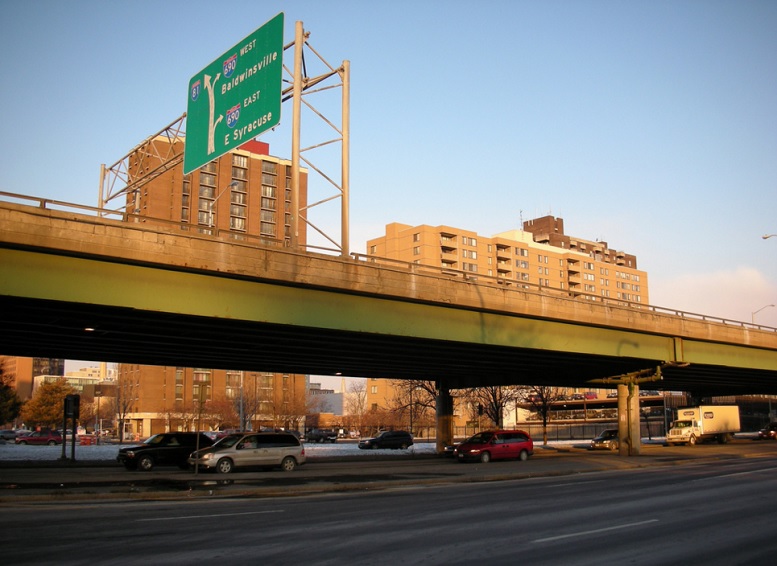We know that air quality impacts health, and given that motor vehicles emit air pollutants, we can deduce that living near highways is unhealthy. And in some cities highways divide communities and squeeze exhaust-spewing cars and trucks right through neighborhoods, often placing a disproportionate burden on low-income and disadvantaged communities.
The Centers for Disease Control and Prevention has come to the conclusion that there is sufficient evidence of a causal relationship between living close to highways and a host of health concerns: respiratory and cardiovascular mortality, childhood leukemia, pre-term and low-birthweight infants, all-cause mortality. They conservatively estimate that roughly 4 percent of the population in the United States lives within 500 feet of a major highway.
The culprit is air pollution, a noxious mixture of stuff we mostly can’t see: carbon monoxide, nitrous oxide, particulate matter, hydrocarbons, and metals like iron and nickel. When mixed together, reactions form the additional bad-guy: ground-level ozone. Vehicle emissions have doubled since the 1970s, but it wasn’t until 1997 that the Environmental Protection Administration (EPA) started regulating particulates. Unfortunately, today, the really dangerous ones—ultrafine particles, which tend to stick closer to highways—still aren’t regulated.
The way we currently monitor and measure local air pollution, unfortunately, doesn’t always lead to solutions. EPA monitoring networks are limited. For example, in Syracuse, where they are contemplating taking down I-81, there is just one air quality monitoring station in the entire county. That makes comparative analysis difficult. Most academic studies trying to understand the impact of pollution near highways look at hourly traffic volumes and speeds to determine emissions, which provides insufficient data for particulate analysis.
Google is piloting a program to monitor urban air pollution, so hopefully better data is on the way. And this week, the Obama administration introduced a new rule for transportation projects that would, for the first time ever, require those who use federal transportation dollars to begin to measure, and set targets, for on-road emissions. The hope is that transparency and better reporting will lead to more sustainable decisions about how we go about improving our transportation networks. It seems clear though, that the rule doesn’t go far enough, especially with the measurement of congestion.
The data that does exist shows that air pollutant concentration goes down very quickly when you move away from highways. In a study to be released this week, a mobile testing lab found that during rush hour, 100 meters from Interstate 93 in Boston, there were 120,000 ultrafine particles per cubic centimeter of air; a few blocks away, it was 40,000 particles. If one were to disperse that traffic into street network, by taking down the urban highway and replacing it with a boulevard, you would also disperse the concentration of air pollution—increasing the opportunities for air flow and greenery to whisk some of the dilemma away. (Interestingly, if highway traffic pollutants are concentrated in one area—by digging a tunnel, as happened in Boston’s Big Dig for example–and as proponents of Save I-81 want—the problem gets worse, especially near tunnel exhaust vents.
US Transportation Secretary Anthony Foxx has recently launched a campaign to take urban highways down, but unfortunately, highway removal isn’t on the list of the Environmental Protection Agency’s mitigation strategies for air quality problems. Instead the EPA talks about building walls, installing air filtration devices, planting roadside vegetation, reducing tailpipe emissions, and planning future development away from the highway—impractical solutions for our most densely-populated urban areas.
So, perhaps this Earth Day the USDOT and EPA get together to start a conversation about a national policy to improve the air in our cities by taking down urban highways. Fortunately, the philanthropic community is taking a lead on these types of initiatives: TSTC has received a grant from the New York Community Trust to help cities convert highways to boulevards.
Support our fight for stronger transit networks and safer streets for biking and walking this Earth Day by making a contribution to our fundraising campaign.


[…] The first response to an air quality alert is usually to advise people to stay inside and to avoid strenuous activity outside. It’s certainly not a bad idea, but this type of messaging addresses only the symptoms, not the cause of air pollution. […]